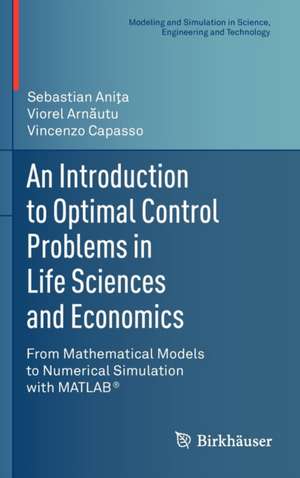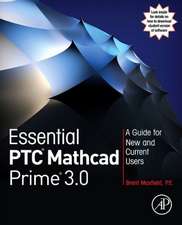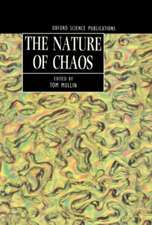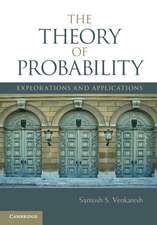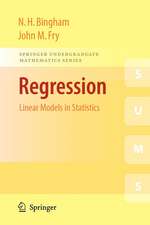An Introduction to Optimal Control Problems in Life Sciences and Economics: From Mathematical Models to Numerical Simulation with MATLAB®: Modeling and Simulation in Science, Engineering and Technology
Autor Sebastian Aniţa, Viorel Arnăutu, Vincenzo Capassoen Limba Engleză Hardback – 28 oct 2010
Emphasizing "learning by doing," the authors focus on examples and applications to real-world problems. An elementary presentation of advanced concepts, proofs to introduce new concepts, and carefully presented MATLAB® programs guide the reader through methods in optimal control and related models. This approach not only fosters an understanding of the basic topics, but also leads the way to new, independent research.
With minimal prerequisites and exercises in each chapter, An Introduction to Optimal Control Problems in Life Sciences and Economics, serves as an excellent textbook for graduate and advanced undergraduate courses in mathematics, physics, engineering, computer science, as well as biology, biotechnology, economics, and finance. The work is also a useful reference for researchers and practitioners working with optimal control theory in the above areas.
Din seria Modeling and Simulation in Science, Engineering and Technology
-
 Preț: 410.88 lei
Preț: 410.88 lei - 18%
 Preț: 958.38 lei
Preț: 958.38 lei - 18%
 Preț: 784.13 lei
Preț: 784.13 lei - 15%
 Preț: 551.02 lei
Preț: 551.02 lei - 15%
 Preț: 642.68 lei
Preț: 642.68 lei -
 Preț: 392.60 lei
Preț: 392.60 lei -
 Preț: 388.34 lei
Preț: 388.34 lei - 18%
 Preț: 950.03 lei
Preț: 950.03 lei - 15%
 Preț: 643.84 lei
Preț: 643.84 lei - 15%
 Preț: 649.39 lei
Preț: 649.39 lei - 15%
 Preț: 644.18 lei
Preț: 644.18 lei - 20%
 Preț: 651.57 lei
Preț: 651.57 lei - 18%
 Preț: 1238.42 lei
Preț: 1238.42 lei - 15%
 Preț: 639.25 lei
Preț: 639.25 lei -
 Preț: 399.12 lei
Preț: 399.12 lei - 15%
 Preț: 650.19 lei
Preț: 650.19 lei -
 Preț: 387.58 lei
Preț: 387.58 lei -
 Preț: 392.97 lei
Preț: 392.97 lei -
 Preț: 396.24 lei
Preț: 396.24 lei - 15%
 Preț: 661.32 lei
Preț: 661.32 lei -
 Preț: 396.24 lei
Preț: 396.24 lei - 18%
 Preț: 943.88 lei
Preț: 943.88 lei - 18%
 Preț: 1386.17 lei
Preț: 1386.17 lei - 15%
 Preț: 648.42 lei
Preț: 648.42 lei - 15%
 Preț: 648.24 lei
Preț: 648.24 lei -
 Preț: 405.06 lei
Preț: 405.06 lei - 15%
 Preț: 641.38 lei
Preț: 641.38 lei - 15%
 Preț: 649.71 lei
Preț: 649.71 lei - 18%
 Preț: 1220.88 lei
Preț: 1220.88 lei - 15%
 Preț: 640.06 lei
Preț: 640.06 lei - 18%
 Preț: 952.26 lei
Preț: 952.26 lei - 15%
 Preț: 640.88 lei
Preț: 640.88 lei -
 Preț: 383.50 lei
Preț: 383.50 lei - 18%
 Preț: 1232.26 lei
Preț: 1232.26 lei - 15%
 Preț: 644.49 lei
Preț: 644.49 lei - 15%
 Preț: 655.60 lei
Preț: 655.60 lei -
 Preț: 400.26 lei
Preț: 400.26 lei - 23%
 Preț: 657.13 lei
Preț: 657.13 lei
Preț: 392.75 lei
Nou
Puncte Express: 589
Preț estimativ în valută:
75.15€ • 78.66$ • 62.55£
75.15€ • 78.66$ • 62.55£
Carte tipărită la comandă
Livrare economică 31 martie-14 aprilie
Preluare comenzi: 021 569.72.76
Specificații
ISBN-13: 9780817680978
ISBN-10: 0817680977
Pagini: 232
Ilustrații: XII, 232 p.
Dimensiuni: 155 x 235 x 16 mm
Greutate: 0.53 kg
Ediția:2011
Editura: Birkhäuser Boston
Colecția Birkhäuser
Seria Modeling and Simulation in Science, Engineering and Technology
Locul publicării:Boston, MA, United States
ISBN-10: 0817680977
Pagini: 232
Ilustrații: XII, 232 p.
Dimensiuni: 155 x 235 x 16 mm
Greutate: 0.53 kg
Ediția:2011
Editura: Birkhäuser Boston
Colecția Birkhäuser
Seria Modeling and Simulation in Science, Engineering and Technology
Locul publicării:Boston, MA, United States
Public țintă
GraduateCuprins
An Introduction to MATLAB. Elementary Models with Applications.- Optimal Control of Ordinary Differential Systems. Optimality Conditions.- Optimal Control of Ordinary Differential Systems. Gradient Methods.- Optimal Harvesting for Age-Structured Population.- Optimal Control of Diffusive Models.- Appendices.- References.- Index.
Recenzii
From the reviews:
“This textbook for graduate students introduces the reader to the basic results and methods in optimal control and applies these methods to problems in life sciences and economics, using MATLAB. … The book contains many figures and MATLAB programs … . Each chapter is concluded with bibliographical notes and theoretical and MATLAB exercises. In a short appendix, basic results from functional analysis and ODEs are provided.” (W. Huyer, Monatshefte für Mathematik, 2013)
“This is an interesting and useful textbook that introduces the reader to methods of optimal control through easily accessible exercises. It is possible to read the book with no knowledge of MATLAB and only some basic knowledge of calculus, which makes most parts truly accessible to undergraduate students.” (Urszula Ledzewicz, SIAM Review, Vol. 53 (4), 2011)
“This book is a guide for those interested in solving real world optimal control problems, including both the theoretical analysis of their mathematical models and suitable computer programs for numerical simulation. The book is self-contained. … An extensive reference list and an index are also included. The book is intended for graduate students and researchers in mathematics, biology, economics, engineering, and other fields.” (Gheorghe Moroşanu, Zentralblatt MATH, Vol. 1206, 2011)
[T]his is an interesting and useful textbook that introduces the reader to methods of optimal control through easily accessible exercises. It is possible to read the book with no knowledge of MATLAB and only some basic knowledge of calculus, which makes most parts truly accessible to undergraduate students. —SIAM
“This textbook for graduate students introduces the reader to the basic results and methods in optimal control and applies these methods to problems in life sciences and economics, using MATLAB. … The book contains many figures and MATLAB programs … . Each chapter is concluded with bibliographical notes and theoretical and MATLAB exercises. In a short appendix, basic results from functional analysis and ODEs are provided.” (W. Huyer, Monatshefte für Mathematik, 2013)
“This is an interesting and useful textbook that introduces the reader to methods of optimal control through easily accessible exercises. It is possible to read the book with no knowledge of MATLAB and only some basic knowledge of calculus, which makes most parts truly accessible to undergraduate students.” (Urszula Ledzewicz, SIAM Review, Vol. 53 (4), 2011)
“This book is a guide for those interested in solving real world optimal control problems, including both the theoretical analysis of their mathematical models and suitable computer programs for numerical simulation. The book is self-contained. … An extensive reference list and an index are also included. The book is intended for graduate students and researchers in mathematics, biology, economics, engineering, and other fields.” (Gheorghe Moroşanu, Zentralblatt MATH, Vol. 1206, 2011)
[T]his is an interesting and useful textbook that introduces the reader to methods of optimal control through easily accessible exercises. It is possible to read the book with no knowledge of MATLAB and only some basic knowledge of calculus, which makes most parts truly accessible to undergraduate students. —SIAM
Notă biografică
Sebastian Aniţa is Full Professor on the Faculty of Mathematics at the University “Al.I. Cuza” Iaşi, Romania. His research interests include: optimal control of partial differential equations; mathematical biology; mathematical models in the applied sciences; and industrial problems in the areas of heat transfer and materials science. Professor Aniţa is the author of more than 50 scientific papers in refereed international journals, one monograph, and three textbooks.
Viorel Arnaŭtu is Full Professor on the Faculty of Mathematics at the University “Al.I. Cuza” Iaşi, Romania. His research interests include: numerical methods (theory, algorithms and computer programs) for optimal control problems; numerical methods for Hamilton-Jacobi equations; numerical methods for PDEs and integral equations; and applications to free boundary problems, epidemic models, optimization of plates, laser hardening of steel, 3-D curved mechanical structures, and population dynamics. Professor Arnaŭtu is the author of more than 30 scientific papers in refereed international journals, one monograph, and one textbook.
Vincenzo Capasso is Professor of Probability and Mathematical Statistics at the University of Milano, Italy. He is the Founder and Director of MIRIAM (Milan Research Centre for Industrial and Applied Mathematics) and later of ADAMSS (Research Centre for Advanced Applied Mathematical and Statistical Sciences) at the University of Milan. His research interests include: spatially structured stochastic processes; stochastic geometry; reaction-diffusion systems; statistics of structured stochastic processes; and applications to biology, medicine, and industrial problems. Professor Capasso is the author of more than 150 scientific papers and approximately 10 monographs, edited books, and textbooks by international scientific publishing companies.
Viorel Arnaŭtu is Full Professor on the Faculty of Mathematics at the University “Al.I. Cuza” Iaşi, Romania. His research interests include: numerical methods (theory, algorithms and computer programs) for optimal control problems; numerical methods for Hamilton-Jacobi equations; numerical methods for PDEs and integral equations; and applications to free boundary problems, epidemic models, optimization of plates, laser hardening of steel, 3-D curved mechanical structures, and population dynamics. Professor Arnaŭtu is the author of more than 30 scientific papers in refereed international journals, one monograph, and one textbook.
Vincenzo Capasso is Professor of Probability and Mathematical Statistics at the University of Milano, Italy. He is the Founder and Director of MIRIAM (Milan Research Centre for Industrial and Applied Mathematics) and later of ADAMSS (Research Centre for Advanced Applied Mathematical and Statistical Sciences) at the University of Milan. His research interests include: spatially structured stochastic processes; stochastic geometry; reaction-diffusion systems; statistics of structured stochastic processes; and applications to biology, medicine, and industrial problems. Professor Capasso is the author of more than 150 scientific papers and approximately 10 monographs, edited books, and textbooks by international scientific publishing companies.
Textul de pe ultima copertă
Combining two important and growing areas of applied mathematics—control theory and modeling—this textbook introduces and builds on methods for simulating and tackling problems in a variety of applied sciences. Control theory has moved from primarily being used in engineering to an important theoretical component for optimal strategies in other sciences, such as therapies in medicine or policy in economics. Applied to mathematical models, control theory has the power to change the way we view biological and financial systems, taking us a step closer to solving concrete problems that arise out of these systems.
Emphasizing "learning by doing," the authors focus on examples and applications to real-world problems, stressing concepts and minimizing technicalities. An elementary presentation of advanced concepts from the mathematical theory of optimal control is provided, giving readers the tools to solve significant and realistic problems. Proofs are also given whenever they may serve as a guide to the introduction of new concepts. This approach not only fosters an understanding of how control theory can open up modeling in areas such as the life sciences, medicine, and economics, but also guides readers from applications to new, independent research.
Key features include:
* An introduction to the main tools of MATLAB®, as well as programs that move from relatively simple ODE applications to more complex PDE models;
* Numerous applications to a wide range of subjects, including HIV and insulin treatments, population dynamics, and stock management;
* Exploration of cutting-edge topics in later chapters, such as optimal harvesting and optimal control of diffusive models, designed to stimulate further research and theses projects;
* Exercises in each chapter, allowing students a chance to work with MATLAB and achieve a better grasp of the applications;
* Minimal prerequisites: undergraduate-level calculus;
*Appendices with basic concepts and results from functional analysis and ordinary differential equations, including Runge–Kutta methods;
* Supplementary MATLAB files are available at the publisher’s website: http://www.birkhauser-science.com/978-0-8176-8097-8/.
As a guided tour to methods in optimal control and related computational methods for ODE and PDE models, An Introduction to Optimal Control Problems in Life Sciences and Economics serves as an excellent textbook for graduate and advanced undergraduate courses in mathematics, physics, engineering, computer science, biology, biotechnology, and economics. The work is also a useful reference for researchers and practitioners working with optimal control theory in these areas.
Emphasizing "learning by doing," the authors focus on examples and applications to real-world problems, stressing concepts and minimizing technicalities. An elementary presentation of advanced concepts from the mathematical theory of optimal control is provided, giving readers the tools to solve significant and realistic problems. Proofs are also given whenever they may serve as a guide to the introduction of new concepts. This approach not only fosters an understanding of how control theory can open up modeling in areas such as the life sciences, medicine, and economics, but also guides readers from applications to new, independent research.
Key features include:
* An introduction to the main tools of MATLAB®, as well as programs that move from relatively simple ODE applications to more complex PDE models;
* Numerous applications to a wide range of subjects, including HIV and insulin treatments, population dynamics, and stock management;
* Exploration of cutting-edge topics in later chapters, such as optimal harvesting and optimal control of diffusive models, designed to stimulate further research and theses projects;
* Exercises in each chapter, allowing students a chance to work with MATLAB and achieve a better grasp of the applications;
* Minimal prerequisites: undergraduate-level calculus;
*Appendices with basic concepts and results from functional analysis and ordinary differential equations, including Runge–Kutta methods;
* Supplementary MATLAB files are available at the publisher’s website: http://www.birkhauser-science.com/978-0-8176-8097-8/.
As a guided tour to methods in optimal control and related computational methods for ODE and PDE models, An Introduction to Optimal Control Problems in Life Sciences and Economics serves as an excellent textbook for graduate and advanced undergraduate courses in mathematics, physics, engineering, computer science, biology, biotechnology, and economics. The work is also a useful reference for researchers and practitioners working with optimal control theory in these areas.
Caracteristici
An introduction to the main tools of MATLAB, as well as programs that move from relatively simple ODE applications to more complex PDE models Numerous applications to a wide range of subject areas, including HIV and insulin treatments, population dynamics, and stock management Exploration of cutting-edge topics in later chapters designed to stimulate further research and theses projects Exercises in each chapter Includes supplementary material: sn.pub/extras
